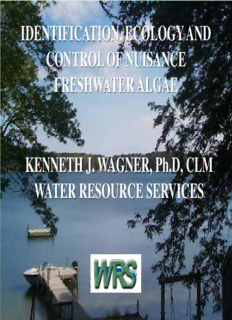
ALGAL PROBLEMS Taste and Odor T&O by diatoms PDF
Preview ALGAL PROBLEMS Taste and Odor T&O by diatoms
IDENTIFICATION, ECOLOGY AND CONTROL OF NUISANCE FRESHWATER ALGAE KENNETH J. WAGNER, Ph.D, CLM WATER RESOURCE SERVICES PART 1: THE PROBLEMS ALGAL PROBLEMS Algal problems include: • Ecological imbalances • Physical impacts on the aquatic system • Water quality alteration • Aesthetic impairment • Taste and odor • Toxicity ALGAL PROBLEMS Ecological Imbalances High algal densities: • Result from overly successful growth processes and insufficient loss processes • Represent inefficient processing of energy by higher trophic levels • May direct energy flow to benthic/detrital pathways • May actually reduce system productivity (productivity tends to be highest at intermediate biomass) ALGAL PROBLEMS Aesthetic Impairment High algal densities lead to: • High solids, low clarity • High organic content • Fluctuating DO and pH • “Slimy” feel to the water • Unaesthetic appearance • Taste and odor • Possible toxicity ALGAL PROBLEMS Taste and Odor • At sufficient density, all algae can produce taste and odor by virtue of organic content and decay • Some algae produce specific taste and odor compounds that are released into the water • Geosmin and Methylisoborneol (MIB) are the two most common T&O compounds; these can induce T&O at very low concentrations ALGAL PROBLEMS Taste and Odor T&O by blue-greens • Anabaena, Aphanizomenon, Microcystis, and Oscillatoria are most common T&O producers, but many other genera produce T&O as well • Geosmin and MIB often produced • Odors usually include musty, grassy, and septic • May be produced by planktonic or benthic growths ALGAL PROBLEMS Taste and Odor T&O by greens • Chara, Cladophora, Chlorococcales (Dictyosphaerium, Scenedesmus, Pediastrum, Hydrodictyon), Volvocales (Chlamydomonas, Volvox), and desmids (Staurastrum, Closterium, Cosmarium, Spirogyra) are primary greens causing T&O, but almost any genus can induce T&O at high density • Main odors are fishy, skunky, musty, grassy and septic (wide range, species-specific) • Not usually as severe as with blue-greens ALGAL PROBLEMS Taste and Odor T&O by diatoms • Melosira/Aulacoseira, Stephanodiscus, Cyclotella, Asterionella, Fragilaria/Synedra, and Tabellaria are primary diatoms causing T&O, usually only at high density • Main odors are geranium, spicy and fishy, with occasional musty or grassy scent • Not as severe as with blue-greens unless diatom density is very high ALGAL PROBLEMS Taste and Odor T&O by goldens • Synura, Dinobryon, Mallomonas, Uroglenopsis, and Chrysosphaerella are major T&O producers, others impart odor at high density Main odors are cucumber, violet, spicy and fishy • Can produce substantial T&O even at low density
Description: